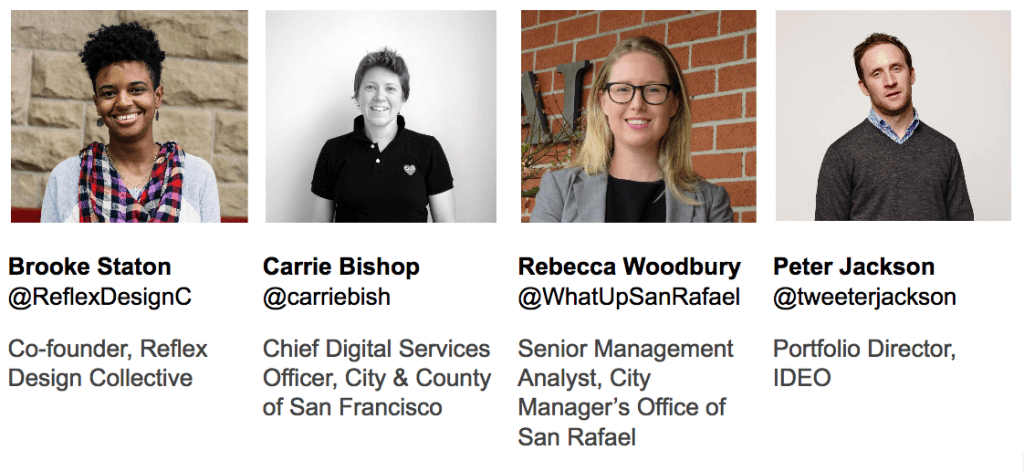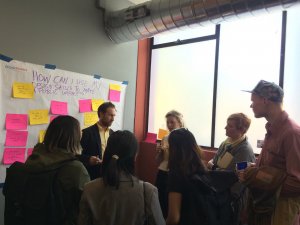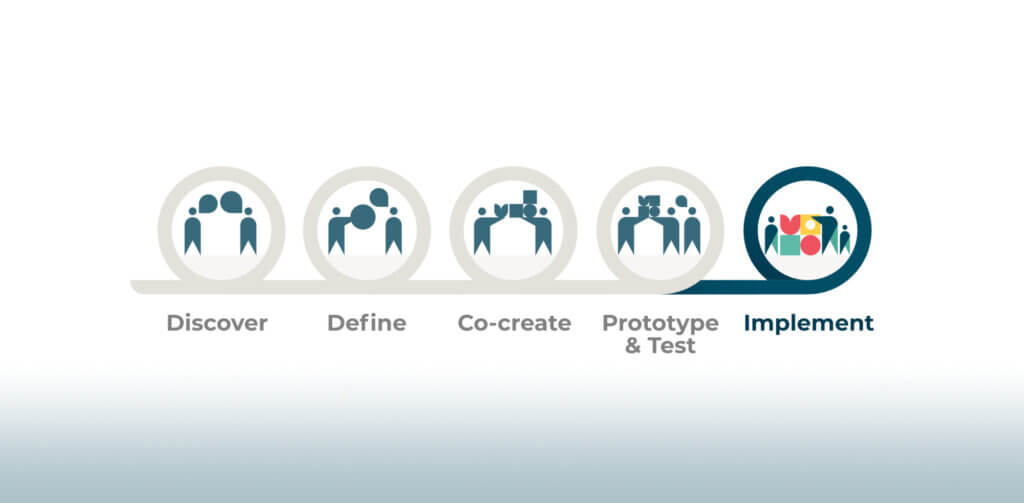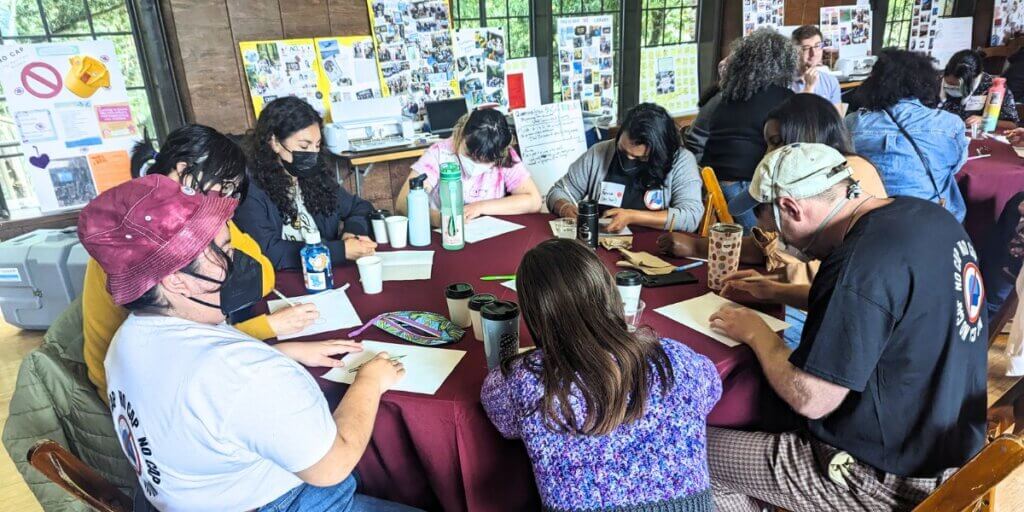Translating Design into the Public Sector (SF Design Week: Volume II)

During SF Design Week (SFDW), we asked people to consider how service design informs the development and delivery of public services.
To explore this subject further, we invited Brooke Staton (Reflex Design Collective), Carrie Bishop (San Francisco Digital Services), Rebecca Woodbury (City of San Rafael), and Peter Jackson (IDEO) to offer their insights from the private and public sectors. All of whom performed double duty as both panelists and facilitators over the course of the evening.
Where the first half of the event was guided by our panel, the second half was turned over to the masses. True to the spirit of human-centered design, we invited attendees to set the agenda for the evening’s Happy Hour breakout sessions.
Based on questions attendees posed, and voted on, it quickly became evident that our audience was experiencing diverse challenges, not limited to service design:
- How can I use my design skills to make a public impact?
- How can we infuse more equity in design?
- Where can I join a community interested in public sector design?
- What is needed to embed service design in the public sector?
To engage these topics further, participants were encouraged to talk through pain points and to propose (or promote) solutions. Here is what surfaced:
1. How can I use my design skills to make a public impact?
There is no single way to bring in design techniques, but we need to start exemplifying the ways in which you can. Share your stories of impact — make cases visible, make them accessible.
Communicate for understanding. Where possible, break things down to be digestible and implementable. Transformation can be intimidating — empower groups to understand the process and build their skills incrementally.
Similarly, make your tools available for others. You can help contribute to the community of practice by shaping its toolset and enabling replication and experimentation. Already have something you’d like to showcase? Send it our way and we’d be glad to broadcast it in our LINKS newsletter!
Just as important — share your lessons. Fail early and fail visibly. Carrie Bishop made a great point on this: “Public servants are not risk averse, but rather blame averse.” The culture has to shift to make room for trial and error. Help this change by appropriately valuing the knowledge gained from failure, and by sharing learnings publicly.
And finally — make the case for design, but also make the case against the status quo. Rebecca Woodbury was right in saying that the status quo is the riskier option. This is only heightened any time basic needs aren’t being met or future resilience is threatened…also known as present conditions. To combat stagnation, the risks of inactivity are just as important to weigh and discuss.
2. How can we infuse more equity in design?
This question very quickly evolved into ‘how can we infuse more equity in designers?’
As designers and interviewers, you are the chroniclers. To paraphrase our own Chief Impact Officer, Judi Brown, be careful not to listen through the lens of your own experience. Equity begins with purposeful listening and understanding how people’s experiences differ from our own. As is the same with reducing other forms of bias — know thy blind spots and, where needed, bring another set of ears.
One of the greatest challenges people voiced was how to engage those who have been underrepresented. Where do you look to find the overlooked?
One technique is to tap into the knowledge of others. Ask those around you who else should be reached, who isn’t here? Using snowball sampling, the act of recruiting study participants through referral, can help you to reveal other populations — people who may be valuable contributors, partners and/or champions for your project.
But it’s not only an issue of how to reach people, it’s also a question of how to properly engage with people. How do you engage with people who aren’t receptive? How can you be constructive in the face of push-back? How do you reach people at the extremes of physical ability, mental health or digital literacy?
While so much of your approach will depend on context, it will always be valuable to engage in conversation face-to-face. Listen empathically, seeking to understand the person and validate their experience. Bear in mind that some of these groups may never have been approached before; they may feel excluded or may not even know how to offer insights. Be patient, be genuine, and be transparent.
But before you get to this point…
Take the time to develop a strategy for engagement. Human-Centered Design as a toolset helps you to understand who to reach, how to include them, and when to engage them. The answers to these questions will vary per project, but to meaningfully engage your community it is important to loop them in early to demonstrate their value in the decision-making process and ultimately build trust.
3. Where can I join a community interested in public sector design?
For many people, it can be a challenge to get (and stay) connected with communities of practice. Whether you are new to the subject and feel you lack experience, or you face distance or schedule constraints, there are a number of different ways you can keep up to date and connected.
Here are some great resources, offered up by attendees and our team at CivicMakers, to start getting involved:
Newsletters:
- CivicMakers LINKS newsletter is a twice-monthly dispatch of ideas, events and opportunities for civic and social innovators.
- HCDcoach (with Amanda Q Damewood)
Events:
- Be sure to check out our Eventbrite page for upcoming events!
- Meetup — search for events on the public sector/design/government/civic tech.
- Social Table, by Adaptive Path, hosts quarterly events to explore design for social impact.
- SPUR promotes good planning and good government across the Bay Area through events in San Francisco, Oakland and San Jose.
Participate:
As an Individual:
- Engaging Local Government Leaders (ELGL) is a professional network for local government leaders.
- GovLab (The Governance Lab) is focused on deepening our understanding of how to govern more effectively and legitimately through technology.
- FUSE Corps runs an executive fellowship program that partners experienced leaders with local governments to tackle challenges facing their community. (1-year fellowship)
- The Brain Spa Creative Retreats. In Portugal, the UnSchool hosts a living laboratory and retreat facility, sustainably designed for creative change-makers to explore regeneration and systems change.
- Look into jobs with SF Digital Services.
As an Organization:
- Startup in Residence connects startups with government agencies to develop technology products that solve real civic challenges. (16-week program)
- OpenIDEO — come as an individual or a team to help co-create solutions to high impact challenges.
Volunteer:
- Code for America is a national network of community organizers and technologists who are putting technology to work for the benefit of our local communities.
- Check out their Local Chapter Brigades such as Open Oakland and Code for San Francisco to learn more about how to get involved!
- Techtonica partners with tech companies to provide free tech training, living stipends, and job placement to women and non-binary, feminine-adjacent adults in need in the Bay Area.
- It’s Your District connects you with community-focused non-profits across San Francisco.
4. What is needed to embed service design in the public sector?
We held four different discussions throughout the room, and yet each conversation touched upon this same question. And each reframed it.
As opposed to addressing how to inject the monolith that is Design into the public sector — how do we nurture people in the public sector as designers? How do we connect well-intentioned, human-centered public servants with the community of design and its vast toolkit?
It starts with internal advocates (maybe that’s you?), people who will champion a human-centered public sector in both intention and practice. But to make the case for design (and oftentimes against the status quo), these people need to be supported by tangible results and relevant metrics of success. This is why it is so important to contribute your success stories, to share your tools and to be involved in the growing community of practice.
Not yet sure where to start? You’re not alone. A number of people expressed their inexperience with design and exasperation with its jargon. This highlights the significant need for translation. At CivicMakers, our work addresses this very challenge around how to apply design to specific issues in the public sector.
But human-centered solutions require the participation and engagement of more…well, humans. So join us, civic designers and enthusiasts, and participate in realizing a more responsive and human-centered public sector!
Thanks again to our sponsor, Twilio, and to Impact Hub San Francisco for helping us to host such a fruitful evening!
Have something that you want to add to the discussion? Here’s a link to the report-back; please leave a comment of what you think is missing or want to build upon!



